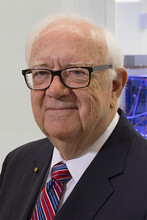Dan Moser, July 21, 2020
Husker scientists fine-tuning skyrmions in bid to improve data storage, processing
The quest to make components ever smaller is a key driver behind the development of the next generation of computer electronics, and University of Nebraska–Lincoln materials scientists’ success at fine-tuning a magnetic material to exhibit extremely small spiral structures at room temperature could play a central role.
The particle-like magnetic configurations are called skyrmions (SKUR’-mee-ahns), a set of atoms whose poles, or magnetic moments, tilt further and further away from the magnetic axis as they approach the skyrmion’s center, with the atom at its core pointing in the opposite direction of that axis. These structures have the potential to improve data storage and processing in multiple computer applications.

David Sellmyer
Nebraska physicists have been studying skyrmions for several years to determine ways to make them smaller and more stable so that they’re useful in practical applications, such as electronics. The Husker team is led by David Sellmyer, George Holmes University Professor of physics and astronomy; Balamurugan Balasubramanian, research assistant professor; and Ralph Skomski, research professor of physics and astronomy, along with collaborators from the Nebraska Center for Materials and Nanoscience and other institutions.

Balamurugan Balasubramanian
Skyrmions do not form above the so-called magnetic ordering temperature of a material, below which the magnetic moments lock in parallel orientations. Conventional wisdom says that high ordering temperatures correspond to large skyrmions. A previous discovery in the nanomaterials field led to the creation of skyrmions in a magnetic material at room temperature, but these skyrmions were relatively large, with a diameter of about 50 nanometers, or roughly 2,000 times thinner than a human hair. While interesting, these skyrmions are not useful for future applications because their size must be much smaller, ideally about 10 nanometers.

Ralph Skomski
An earlier milestone for the Nebraska team was the ability to create much smaller skyrmions, about 13 nanometers in size. However, that was only achieved at a temperature of about minus-382 degrees Fahrenheit. Now, they’ve successfully increased the magnetic ordering temperature of a material whose structure supports skyrmions beyond room temperature and simultaneously shrunk the skyrmion size to about 17 nanometers.
“That’s important because ever-smaller and energy-efficient components are essential to the continual miniaturization in electronics,” Sellmyer said. “In the field of information processing and data storage, the science and engineering community is trying to figure out new physics systems that will make these elements smaller and smaller and use less power so they don’t heat up — and be fast.”
The Nebraska researchers’ findings counter the conventional wisdom that only larger skyrmions could be realized at room temperature because the quantum-mechanical atomic inter¬action “stiffens” the spin structure, simultaneously increasing thermal stability and skyrmion size.
The researchers countered that tendency by adding cobalt to the non-magnetic compound cobalt silicon, gradually replacing the silicon atoms with excess cobalt, which is known to have a positive effect on magnetic ordering temperature. The enhanced cobalt content was realized through a non-equilibrium fabrication process that involved cooling the molten material to room temperature at about 1 million degrees per second.
That process circumvented equilibrium physics and gave magnetic ordering temperatures of about 129 degrees Fahrenheit, which is among the highest of all metal silicides and germanides hosting skyrmions. An analysis of the exchange interactions in the cobalt-rich material showed that the excess cobalt had a bigger effect on the ordering temperature than on the skyrmion size, which explains their small size.
“Normally, if you enhance temperature, it increases the size of skyrmions,” Skomski said. “In this case, there’s a very complicated interaction preventing that.”
The discovery is important for future developments in information science. Researchers hope to develop something called “memory racetracks,” which are nanoscopic stripes that could transport the magnetic vortexes from one group of atoms to another when propelled by an electric current. By bringing those bits to a data reader or writer rather than vice versa, racetrack designs could increase processing speeds and extend the lifespans of data-storage devices.
The team reported its findings in the journal Physical Review Letters. Collaborators include Nebraska doctoral students Rabindra Pahari and Ahsan Ullah and senior research associate Wenyong Zhang, as well as researchers from Cornell University, the University of Delaware and Howard University. The research was supported by the U.S. Department of Energy, with additional support for fabrication and facilities by the National Science Foundation and Nebraska Research Initiative.





